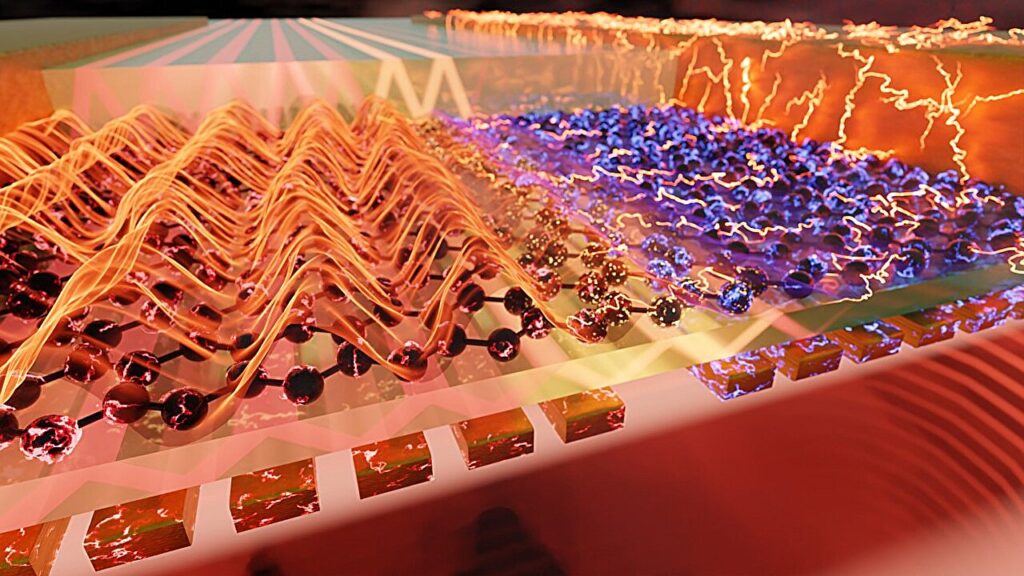Polaritons are coupled excitations of electromagnetic waves with either charged particles or vibrations in the atomic lattice of a given material. They are widely used in nanophotonics because of their ability to confine light at extremely small volumes, on the order of nanometers, which is essential to enhance light-matter interactions.
Two-dimensional materials (that is, materials only one-atom thick) are commonly used for this purpose, since the polaritons they host show even more extreme confinement, lower energy losses—resulting in longer lifetimes, and higher tunability than bulk materials. To achieve even greater control over light confinement and enhance polaritonic properties further, nanoscale structures called nanoresonators can be employed.
In addition, when light interacts with a nanoresonator, it excites polaritons, which oscillate and resonate at specific frequencies determined by the geometry and material properties of the resonator, enabling precise manipulation of light at the nanoscale.
While the use of polaritons for light confinement is an established practice, there is still room for improvement regarding the methods aimed at probing them. In the past years, optical measurements have become a common choice, but their bulky detectors require external equipment.
This limits the miniaturization of the detection system and the signal clarity (known as the signal-to-noise ratio) one can obtain from the measurements, which in turn hinders the application of polaritonic properties in areas where these two features are essential, such as molecular sensing.
Now, researchers have demonstrated in a Nature Communications article the integration of 2D polaritons with a detection system into the same 2D material. The integrated device enables, for the first time, spectrally resolved electrical detection of 2D polaritonic nanoresonators and marks a significant step towards device miniaturization.
The team from ICFO includes Dr. Sebastián Castilla, Dr. Hitesh Agarwal, Dr. David Alcaraz, Dr. Adrià Grabulosa, Matteo Ceccanti, Dr. Roshan Krishna Kumar, led by ICREA Prof. Frank Koppens. Collaborating institutions include the University of Ioannina; Universidade do Minho; the International Iberian Nanotechnology Laboratory; Kansas State University; the National Institute for Materials Science (Tsukuba, Japan); POLIMA (University of Southern Denmark); and URCI (Institute of Materials Science and Computing, Ioannina).
The team applied electrical spectroscopy to a stack of three layers of 2D materials. Specifically, an hBN (hexagonal boron-nitrate) layer was placed on top of graphene, which was layered on another hBN sheet.
During the experiments, researchers identified several advantages of electrical spectroscopy compared to commercial optical techniques. With the former, the spectral range covered is significantly broader (that is, it spans a wider range of frequencies, including the infrared and terahertz ranges), the required equipment is significantly smaller, and the measurements present higher signal-to-noise ratios.
This electro-polaritonic platform represents a breakthrough in the field due to two main features. First, an external detector for spectroscopy, required by most optical techniques, is no longer needed. A single device serves at the same time as a photodetector and a polaritonic platform, therefore enabling further miniaturization of the system.
Second, while in general higher light confinement is detrimental to the quality of this confinement (for instance, shortening durations of light trapping), the integrated device successfully overcomes this limitation.
“Our platforms have exceptional quality, achieving record-breaking optical lateral confinement and high-quality factors of up to 200, approximately. This exceptional level of both confinement and quality of graphene significantly enhances the photodetection efficiency,” explains Dr. Castilla, first co-author of the article.
Moreover, the electrical spectroscopy approach enables the probing of extremely small 2D polaritons (with lateral sizes of around 30 nanometers). “That was highly challenging to detect with conventional techniques due to the imposed resolution limitations,” he adds.
Castilla reflects on what future discoveries could be unlocked by their new approach. “Sensing, hyperspectral imaging, and optical spectrometry applications could benefit from this electro-polaritonic integrated platform.
“For instance, in the case of sensing, on-chip electrical detection of molecules and gases could become possible,” he suggests. “I believe that our work will open the door to many applications that the bulky nature of standard commercial platforms has been inhibiting.”


